“We signal the captain, taking time out against the wall. He frowns. He groans. His feet hurt. His ulcer rages. He hates his wife. The risotto will take 25 minutes. Lasagna will take even longer.”
– Gael Greene, Restaurant Critic, on Manhattan’s Italian Pavilion restaurant, “That’s Italian”, January 1985
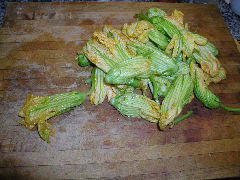 Buenos Aires – Picking up on the long post from yesterday, the remaining dishes in this weekend’s Night of the Radishes feast… I’d covered the first course, the soup, and we moved on to a festive holiday empanada. Traditional from the Oaxaca region are empanadas filled with squash blossoms and a local farmer’s cheese. The cheese, quite similar in texture and flavor to ricotta, so that was an easy substitute. I’d seen squash blossoms in the markets a couple of weeks ago – the question was, would it still be possible to find them? Anyone who’s been reading the last few days knows I found a local verduleria that was willing to order them from the Mercado Central for me –
Buenos Aires – Picking up on the long post from yesterday, the remaining dishes in this weekend’s Night of the Radishes feast… I’d covered the first course, the soup, and we moved on to a festive holiday empanada. Traditional from the Oaxaca region are empanadas filled with squash blossoms and a local farmer’s cheese. The cheese, quite similar in texture and flavor to ricotta, so that was an easy substitute. I’d seen squash blossoms in the markets a couple of weeks ago – the question was, would it still be possible to find them? Anyone who’s been reading the last few days knows I found a local verduleria that was willing to order them from the Mercado Central for me – 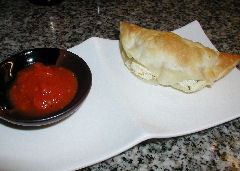 it’s just too long of a trip for me to make just for some squash blossoms. What I didn’t know, was that he got a call back the next day telling him that they weren’t available from there. He then called every supplier he could think of and found a farm somewhere outside of town and got someone to deliver about a pound of them. That’s dedication, it’s also something that you just don’t see from most shopkeepers. But, bright and early on Thursday morning, he had a bag of blossoms awaiting me. I’m also used to squash blossoms being a pricey item back in New York – here, they run 20 pesos for a kilo! Needless to say, after making the empanadas, I delivered a platter of them right out of the oven to he and his staff.
it’s just too long of a trip for me to make just for some squash blossoms. What I didn’t know, was that he got a call back the next day telling him that they weren’t available from there. He then called every supplier he could think of and found a farm somewhere outside of town and got someone to deliver about a pound of them. That’s dedication, it’s also something that you just don’t see from most shopkeepers. But, bright and early on Thursday morning, he had a bag of blossoms awaiting me. I’m also used to squash blossoms being a pricey item back in New York – here, they run 20 pesos for a kilo! Needless to say, after making the empanadas, I delivered a platter of them right out of the oven to he and his staff.
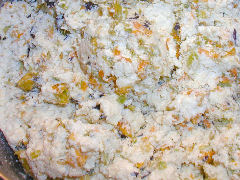 The filling is easy, though each day I played with the ratios a bit – in the end, and this photo is from the second day, I think I ended up with pretty much a 1:1 ratio between chopped blossoms and ricotta, from having started at about 1:2. Traditionally, epazote, a common herb in Mexican cooking is used to season them – I’ve not run into it here, but I still had a bunch of perilla leaves, so I chopped those into the mixture, which seemed to work well. A little salt and ají amarillo powder – I also increased that a bit by the third day, but you don’t want them to be picante, so don’t overdo it. I tried using some different empanada skins this time – what are called criollos – they come out lighter and flakier than the ones I usually use, but also don’t crisp up as much. I think I’ll go back to the others, though I might have to try some side-by-side. I served these with a little sauce made from reconstituted ají panca (amarillo), sun-dried tomatoes, a small amount of onion, vinegar, and salt.
The filling is easy, though each day I played with the ratios a bit – in the end, and this photo is from the second day, I think I ended up with pretty much a 1:1 ratio between chopped blossoms and ricotta, from having started at about 1:2. Traditionally, epazote, a common herb in Mexican cooking is used to season them – I’ve not run into it here, but I still had a bunch of perilla leaves, so I chopped those into the mixture, which seemed to work well. A little salt and ají amarillo powder – I also increased that a bit by the third day, but you don’t want them to be picante, so don’t overdo it. I tried using some different empanada skins this time – what are called criollos – they come out lighter and flakier than the ones I usually use, but also don’t crisp up as much. I think I’ll go back to the others, though I might have to try some side-by-side. I served these with a little sauce made from reconstituted ají panca (amarillo), sun-dried tomatoes, a small amount of onion, vinegar, and salt.
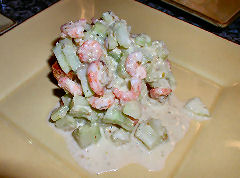 On to the third course, the Camarones en Pepián, or Shrimp in Pumpkin Seed Sauce. Apologies to the folks on day one, I forgot about the sour cream – it was good, but the sauce wasn’t smoothed out the way it should be – what’s funny is I sat there staring at it thinking “hey, the sauce isn’t all creamy the way it should be…” while the sour cream was sitting in the refrigerator, all made and waiting to be added to the dish. This sauce is really easy – toast about two cups of pumpkin seeds until lightly golden, then grind them to a fine powder in the blender. Add a medium sized onion, 4-5 hot peppers (serranos are recommended, I used a mix of serranos and rocotos) a small handful of cilantro leaves (adjust to your personal tastes) and blend. To thin it out to a thick paste consistency, use the saved liquid from cooking your shrimp (on the third night I made a separate batch also with chicken for a couple of folks with shellfish allergies) – the shrimp are simply cooked in milk until they’re pink, then use the milk for the sauce. I added cucumbers to the mix because I simply felt it needed something. You could also use any other vegetables you feel like, or stay with just the shrimp, which might be more interesting with large langostinos than with the baby shrimp I was using. To serve, saute the paste in some butter until it’s bubbling nicely. Add the shrimp (or chicken) and vegetables and continue simmering to cook through. Finish by adding roughly an equal amount of sour cream to the amount of the pumpkin seed paste you used. Season to taste with salt. Serve over toasted bread that’s seasoned with butter, salt, and ground coriander.
On to the third course, the Camarones en Pepián, or Shrimp in Pumpkin Seed Sauce. Apologies to the folks on day one, I forgot about the sour cream – it was good, but the sauce wasn’t smoothed out the way it should be – what’s funny is I sat there staring at it thinking “hey, the sauce isn’t all creamy the way it should be…” while the sour cream was sitting in the refrigerator, all made and waiting to be added to the dish. This sauce is really easy – toast about two cups of pumpkin seeds until lightly golden, then grind them to a fine powder in the blender. Add a medium sized onion, 4-5 hot peppers (serranos are recommended, I used a mix of serranos and rocotos) a small handful of cilantro leaves (adjust to your personal tastes) and blend. To thin it out to a thick paste consistency, use the saved liquid from cooking your shrimp (on the third night I made a separate batch also with chicken for a couple of folks with shellfish allergies) – the shrimp are simply cooked in milk until they’re pink, then use the milk for the sauce. I added cucumbers to the mix because I simply felt it needed something. You could also use any other vegetables you feel like, or stay with just the shrimp, which might be more interesting with large langostinos than with the baby shrimp I was using. To serve, saute the paste in some butter until it’s bubbling nicely. Add the shrimp (or chicken) and vegetables and continue simmering to cook through. Finish by adding roughly an equal amount of sour cream to the amount of the pumpkin seed paste you used. Season to taste with salt. Serve over toasted bread that’s seasoned with butter, salt, and ground coriander.
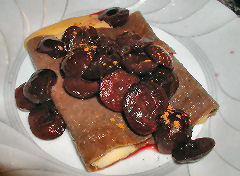 I covered the main course, the mole chatino, yesterday, so it’s on to dessert. This gave me the most difficulty. I wanted to incorporate some classic flavors from the region – Oaxacan chocolate (flavored with cinnamon), dulce de leche (yes, yes, I know Argentines, and Uruguayans, think they invented it… but it’s part of traditional cuisine all over Latin America, and parts of Europe as well), and fresh fruit. I decided on playing with a version of the chocolate pasta dessert I was working on a month or so ago. I was first thinking about a layered lasagna style, but that seemed to be too heavy and too much for a dessert. So I went, the first night, with a lasagna noodle size and shape, and folded them over a mix of dulce de leche and mascarpone cheese, roughly 1:2 on the ratio,
I covered the main course, the mole chatino, yesterday, so it’s on to dessert. This gave me the most difficulty. I wanted to incorporate some classic flavors from the region – Oaxacan chocolate (flavored with cinnamon), dulce de leche (yes, yes, I know Argentines, and Uruguayans, think they invented it… but it’s part of traditional cuisine all over Latin America, and parts of Europe as well), and fresh fruit. I decided on playing with a version of the chocolate pasta dessert I was working on a month or so ago. I was first thinking about a layered lasagna style, but that seemed to be too heavy and too much for a dessert. So I went, the first night, with a lasagna noodle size and shape, and folded them over a mix of dulce de leche and mascarpone cheese, roughly 1:2 on the ratio, 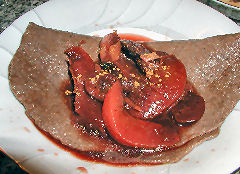 and then topped the whole thing with “red sauce” of cherries that were simmered in caramel liqueur and then dusted it with cinnamon. The only difference from the pasta recipe I used before is I added a half teaspoon of cinnamon to the mix.
and then topped the whole thing with “red sauce” of cherries that were simmered in caramel liqueur and then dusted it with cinnamon. The only difference from the pasta recipe I used before is I added a half teaspoon of cinnamon to the mix.
I wasn’t thrilled with the way it turned out. The flavors were good, but the texture of the dough was almost a little crumbly, and the noodles didn’t hold together well. The next night, I decided to make them more like a round crepe, and leave them slightly thicker, hoping they would hold together better. I also mixed the cherries with some nectarines, and stewed them in white wine and dark brown sugar. 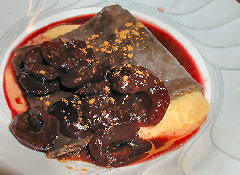 I definitely liked the sauce better the second night, but the “crepes” were simply too heavy, and still cracked and tore in multiple places. For the third night, I thought, maybe it’s the semolina flour, and left it out, just substituting more all purpose flour. I went back to the lasagna shape, and a thickness in between the two previous days – definitely better, much smoother, and they held together better but not completely – still not quite there. I also went back to just cherries, but stuck with the white wine and brown sugar – that seems to be the best of the three versions of the red sauce…
I definitely liked the sauce better the second night, but the “crepes” were simply too heavy, and still cracked and tore in multiple places. For the third night, I thought, maybe it’s the semolina flour, and left it out, just substituting more all purpose flour. I went back to the lasagna shape, and a thickness in between the two previous days – definitely better, much smoother, and they held together better but not completely – still not quite there. I also went back to just cherries, but stuck with the white wine and brown sugar – that seems to be the best of the three versions of the red sauce…
[…] in the market, I thought I’d chop them up finely and mix them in (the idea came from the ricotta and squash blossom empanadas I made wayyyy back). The combo worked […]